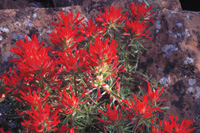If you look up into the sky at a soaring hawk and say, “Red-tailed hawk,” you’d probably be right about 75% of the time. Redtails are one of the most widely distributed hawks in North America and that red tail is a sure giveaway.
This bird of prey is in the group of soaring hawks called “Buteos.” Other local buteos include the ferruginous and Swainson’s hawk, and broad-winged and rough-legged hawks that are migrate through or winter in the area, respectively.
The first redtail collected for science came from Jamaica, hence, its scientific name is Buteo jamaicensis. No, the birds don’t sport dreadlocks, and their call is not, “Ya, Mon.”
But if you happen to watch television, you’ve probably heard the plaintive “keeer-r-r-r” cry of the redtail. One of the more commonly used calls, Hollywood inserts this distinct sound even if the bird on the screen is an owl, duck or sparrow. Scientific accuracy must crowd creative genius.
Here in the Canyonlands Region, redtails are visible year round. They may start their courtship displays in March, and these include stooping flights, soaring with legs dangling and periodic calling. Though redtails probably mate for life, they do not spend all their time together. And if one mate dies, the survivor finds another partner. Nature’s mantra, “Survival of the species must continue,” influences this action.
The answer to where to find redtails is simply, “Pretty much anywhere.” In the sparse and open Cisco Desert, red-tailed hawks build nests in low junipers or on narrow ledges of cliffs. Out there, territories of redtails and ferruginous hawks may overlap and the birds are tolerant of their neighbors. This is because the two prey on different groups. Ferruginous hawks take primarily prairie dogs while the redtails work the mice and rabbit populations.
In the canyons you might find redtails nesting on a ledge or within the protective confines of a large alcove. Redtails like their nest site to be open not tucked into a small alcove like a raven’s nest often is. Look for a cluster of sticks projecting from the ledge and maybe some whitewash down below, a definite clue. When the young are in the nest their tendency is to back up to the edge and poop over the side. This whitewash rains down and stains the wall below the nest. Searching for these obvious patches of white on the redrock walls is a good starting point for locating a nest.
Then again, the birds may select a large cottonwood or conifer in which to build their nest. A bit harder to locate, these large nests are usually high up in the tree and screened by branches. These tree sites and the canyon wall nests may also be in close proximity to another bird of prey, the great horned owl.
Though the two species tend to share the same prey base (rabbits), their hunting periods of day for the hawks and night for the owls, tends to separate the birds and minimize conflicts. Of course, since great horneds eat everything, they have been known to dine on redtail hawk nestlings.
But like the owls, redtails are not parochial in their diets. They consume gopher snakes and rattlesnakes, mice, ground squirrels, rabbits, bats, waterfowl, small birds, grassshoppers, toads, and turtles. And that’s just for starters. I’ve seen these hawks carrying limp snakes in their talons, and I’ve always wanted to see one drop the snake onto the slickrock like a gull dropping clamshells on coastal rocks. Sandstone, the avian meat tenderizer.
There has be a certain level of daring or maybe desperation on the part of the redtail who carries rattlesnakes back to the nest. “Hi Honey, look what I got!” may not win too many partner points if the snake is still alive. Kids definitely do not try this at home.
So this March think red while hiking in Canyon Country. Not only will there be splashes of red on the ground with the Indian paintbrush, Utah penstemon and hedgehog cactus in bloom, but also there should be some up, soaring as well.
